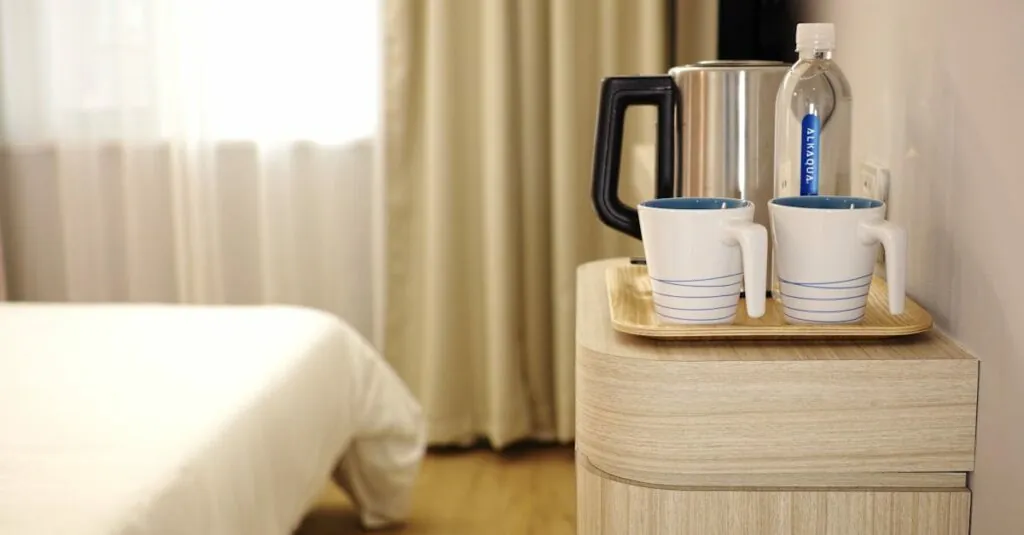Setting up a hospital bed might sound as exciting as watching paint dry, but it’s crucial for patient comfort and recovery. Imagine trying to get a good night’s sleep while wrestling with tangled sheets and awkward bed adjustments. Not exactly a recipe for sweet dreams, right?
A well-set hospital bed can be the difference between feeling like a patient in a boring hospital or a VIP in a five-star suite. From the right mattress to proper positioning, every detail matters. So let’s dive into the art of hospital bed setup and transform that clinical space into a cozy haven. After all, who says healing can’t come with a touch of comfort and a sprinkle of humor?
Table of Contents
ToggleImportance of Hospital Bed Setup
A proper hospital bed setup significantly enhances patient comfort and promotes efficient healthcare delivery. Attention to detail creates an environment conducive to recovery.
Patient Comfort
Creating a comfortable space for patients is essential. The right mattress absorbs pressure, reduces pain, and enhances overall well-being. Adjusting bed positions allows for easier access and a more personalized experience. Familiar bedding items, such as pillows and blankets, add a sense of home. Lighting also contributes to comfort, with softer options fostering relaxation. Additionally, incorporating personal touches can alleviate the clinical atmosphere and improve the overall mood. Comfortable environments support emotional health, ultimately aiding recovery.
Staff Efficiency
Efficient hospital bed setups optimize workflow for staff members. A well-organized arrangement facilitates quicker patient assessments and reduces strain during tasks. Easy access to vital equipment, such as IV poles and monitors, minimizes time spent searching. Proper bed placement supports seamless movement around the room, which enhances team collaboration. Ultimately, streamlined setups can reduce workload, allowing healthcare professionals to provide better care. When staff efficiency improves, patients receive timely assistance, leading to enhanced overall patient satisfaction.
Key Components of Hospital Bed Setup
A well-structured hospital bed setup includes crucial elements that enhance patient care. Understanding each component contributes significantly to a more comfortable and safe experience.
Adjustable Features
Adjustable features play a vital role in hospital bed setups. Models typically allow head and foot sections to elevate, catering to individual patient needs. Patients can find their optimal comfort positions for eating, reading, or resting. Often, electric or manual adjustments assist caregivers in repositioning patients easily. Adjustable beds also enable healthcare professionals to provide better care during examinations or treatments. Increased flexibility reduces the likelihood of bedsores and improves overall patient mobility.
Safety Elements
Safety elements are essential for preventing accidents in a hospital environment. Bed rails, commonly found on many models, help prevent falls during the night. Staff should always ensure that these rails are securely fastened when in use. Moreover, anti-tripping designs, such as lowered frames, enhance mobility and prevent injuries. Emergency brake systems on wheels allow beds to remain stationary during procedures. Clear visibility and proper labeling of controls ensure that caregivers can make quick adjustments as needed. These features collectively create a safer environment, allowing patients to focus on their recovery.
Steps for Effective Hospital Bed Setup
Effective hospital bed setup involves careful preparation and strategic positioning to enhance patient comfort and safety.
Preparation of the Environment
Begin by assessing the patient’s needs and preferences. Identify necessary equipment, such as IV poles and monitors, and ensure easy access. Clear clutter near the bed to create a safe and inviting space. Adjust the room temperature to a comfortable level, promoting relaxation. Utilize soft lighting, which can alleviate stress and anxiety. Incorporate familiar items, like blankets or photographs, adding a personal touch that fosters a sense of home. This combination of careful preparation and personal elements helps create a supportive environment that aids recovery.
Positioning the Bed
Proper bed positioning is vital for patient comfort and safety. Elevate the head and foot sections based on individual needs. Align the bed with the room’s features, ensuring patients can reach necessary items without strain. Maintain a distance of at least 3 feet from the wall, allowing caregivers to move freely. Also, adjust the mattress to prevent compression and promote circulation. For enhanced accessibility, ensure bedside controls are easily reachable. These strategic positioning steps significantly contribute to both comfort and efficient care delivery.
Common Mistakes in Hospital Bed Setup
Improper hospital bed setup can hinder patient recovery and comfort. Awareness of common mistakes ensures better outcomes for patients.
Neglecting Patient Needs
Overlooking patient preferences leads to discomfort. Conversations with patients about their needs create a more personalized setup. Placing call buttons within reach empowers patients and promotes independence. Ignoring individual requirements may result in increased anxiety or stress. Understanding the importance of proper mattress selection significantly impacts patient comfort. Ensuring that bed height accommodates easy access for caregivers reduces strain during assistance. Ultimately, factoring in the patient’s specific needs enhances their experience and supports effective healing.
Inadequate Safety Measures
Neglecting safety measures increases risks for patients. Not securing bed rails may lead to falls, jeopardizing patient safety. Staff should install bed controls that are easily operable and clearly labeled for accessibility. Using non-slip mats around the bed area enhances footing and prevents accidents. Implementing emergency brake systems ensures stability, especially during patient transfers. Regular checks on equipment guarantee that safety features function correctly. These proactive steps enhance the security of the environment, allowing patients to focus on recovery without fear of injury.
Conclusion
A well-executed hospital bed setup plays a crucial role in enhancing patient comfort and overall recovery. By focusing on individual needs and preferences, healthcare providers can create a nurturing environment that feels less clinical. Incorporating adjustable features and essential safety elements not only promotes comfort but also supports efficient care delivery.
Attention to detail such as lighting, familiar items, and clutter-free spaces fosters a sense of home, which is vital for emotional well-being. By prioritizing these aspects, healthcare professionals can significantly improve patient experiences, ensuring they feel cared for and secure during their stay. Ultimately, a thoughtful hospital bed setup can transform the healing process, making it more effective and compassionate.








